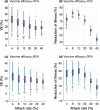Projecting influenza vaccine effectiveness: A simulation study
- PMID: 33141871
- PMCID: PMC7608924
- DOI: 10.1371/journal.pone.0241549
Projecting influenza vaccine effectiveness: A simulation study
Abstract
The impact of influenza vaccination is largely measured by estimating vaccine effectiveness (VE), which vary in different seasons. Strain mutations and waning immunity present two key mechanisms affecting VE. We sought to quantify the relative effect of these mechanisms by projecting VE and the reduction of illness due to vaccination. We developed a stochastic age-structured agent-based simulation model of influenza transmission dynamics to encapsulate intraseason waning of immunity post-vaccination, and mutation-induced antigenic distance between circulating strains and vaccine strains. Parameterizing the model with published estimates, we projected the temporal and overall VE during an epidemic season, and estimated the reduction of infection for high (70%) and low (30%) vaccine efficacies to reflect the levels of vaccine-induced protection in randomized control trials. Both temporal and overall VE decreased as the attack rate increased, with lower median values for epidemics starting with strains that were antigenically more distant from vaccine strains. We observed a higher rate of temporal decline with considerably lower median values of the overall VE in the presence of intraseason waning of immunity compared with only the antigenic distance effect. The highest benefit of vaccination in preventing influenza infection was achieved at moderate attack rates in the range of 6%-15%. The results show that even when VE is relatively low in the population and almost negligible for older age groups (i.e., 50+ years), vaccination can still prevent significant illness in high-risk individuals; thereby reducing healthcare resource utilization and economic burden. Our study indicates that early vaccination remains an important strategy for alleviating the burden of seasonal influenza. Policy discussions on optimal timing of vaccination to reduce the effect of intraseason waning of immunity should be considered in the context of strain mutations within the epidemic course.
Conflict of interest statement
SMM has previously been commissioned by Medicago Inc. This does not alter our adherence to PLOS ONE policies on sharing data and materials. No other competing interests are declared.
Figures





Similar articles
-
Intraseason waning of influenza vaccine protection: Evidence from the US Influenza Vaccine Effectiveness Network, 2011-12 through 2014-15.Clin Infect Dis. 2017 Mar 1;64(5):544-550. doi: 10.1093/cid/ciw816. Epub 2016 Dec 29. Clin Infect Dis. 2017. PMID: 28039340
-
Beyond Antigenic Match: Possible Agent-Host and Immuno-epidemiological Influences on Influenza Vaccine Effectiveness During the 2015-2016 Season in Canada.J Infect Dis. 2017 Dec 19;216(12):1487-1500. doi: 10.1093/infdis/jix526. J Infect Dis. 2017. PMID: 29029166 Free PMC article.
-
Intraseason decline in influenza vaccine effectiveness during the 2016 southern hemisphere influenza season: A test-negative design study and phylogenetic assessment.Vaccine. 2019 May 1;37(19):2634-2641. doi: 10.1016/j.vaccine.2019.02.027. Epub 2019 Apr 2. Vaccine. 2019. PMID: 30952499
-
Seasonal influenza vaccines.Curr Top Microbiol Immunol. 2009;333:43-82. doi: 10.1007/978-3-540-92165-3_3. Curr Top Microbiol Immunol. 2009. PMID: 19768400 Review.
-
Challenges in estimating influenza vaccine effectiveness.Expert Rev Vaccines. 2019 Jun;18(6):615-628. doi: 10.1080/14760584.2019.1622419. Epub 2019 May 31. Expert Rev Vaccines. 2019. PMID: 31116070 Free PMC article. Review.
Cited by
-
SARS-CoV-2 Vaccine Alpha and Delta Variant Breakthrough Infections Are Rare and Mild but Can Happen Relatively Early after Vaccination.Microorganisms. 2022 Apr 21;10(5):857. doi: 10.3390/microorganisms10050857. Microorganisms. 2022. PMID: 35630302 Free PMC article.
-
Factors associated with influenza vaccine adherence among health care workers in Abu Dhabi.S Afr J Infect Dis. 2025 Jul 15;40(1):696. doi: 10.4102/sajid.v40i1.696. eCollection 2025. S Afr J Infect Dis. 2025. PMID: 40800238 Free PMC article.
References
-
- Fiore AE, Shay DK, Broder K, Iskander JK, Uyeki TM, Mootrey G, et al. Prevention and control of seasonal influenza with vaccines: recommendations of the Advisory Committee on Immunization Practices (ACIP), 2009. MMWR Recomm Rep. 2009;58:1–52. - PubMed
Publication types
MeSH terms
Substances
LinkOut - more resources
Full Text Sources
Medical

